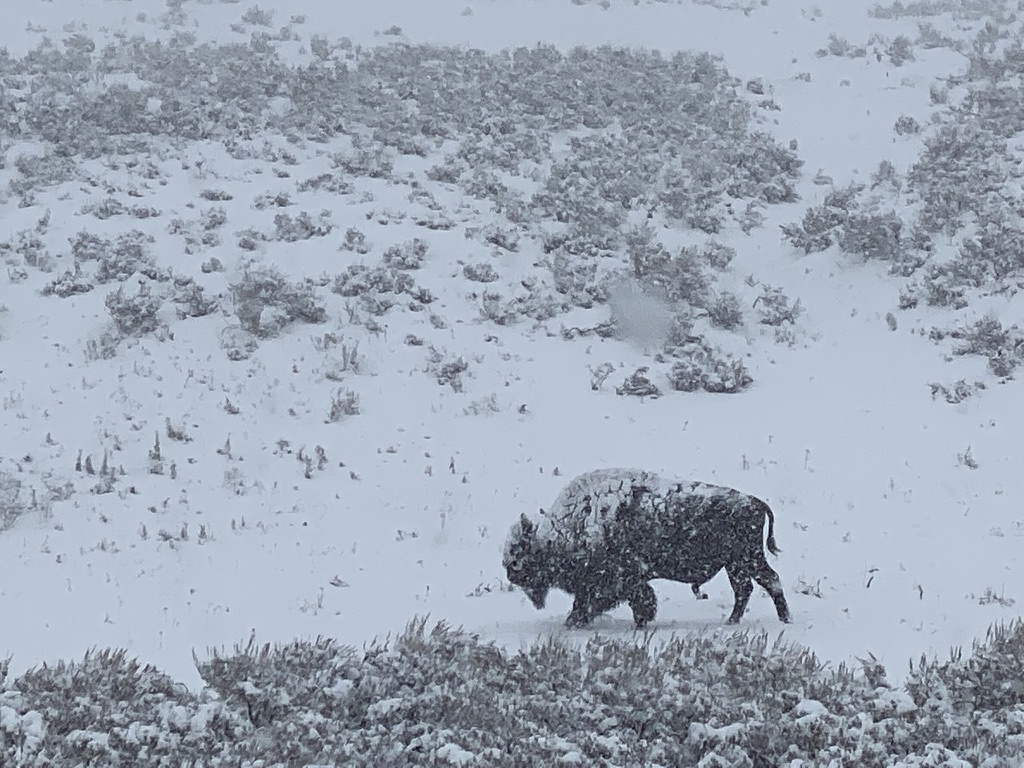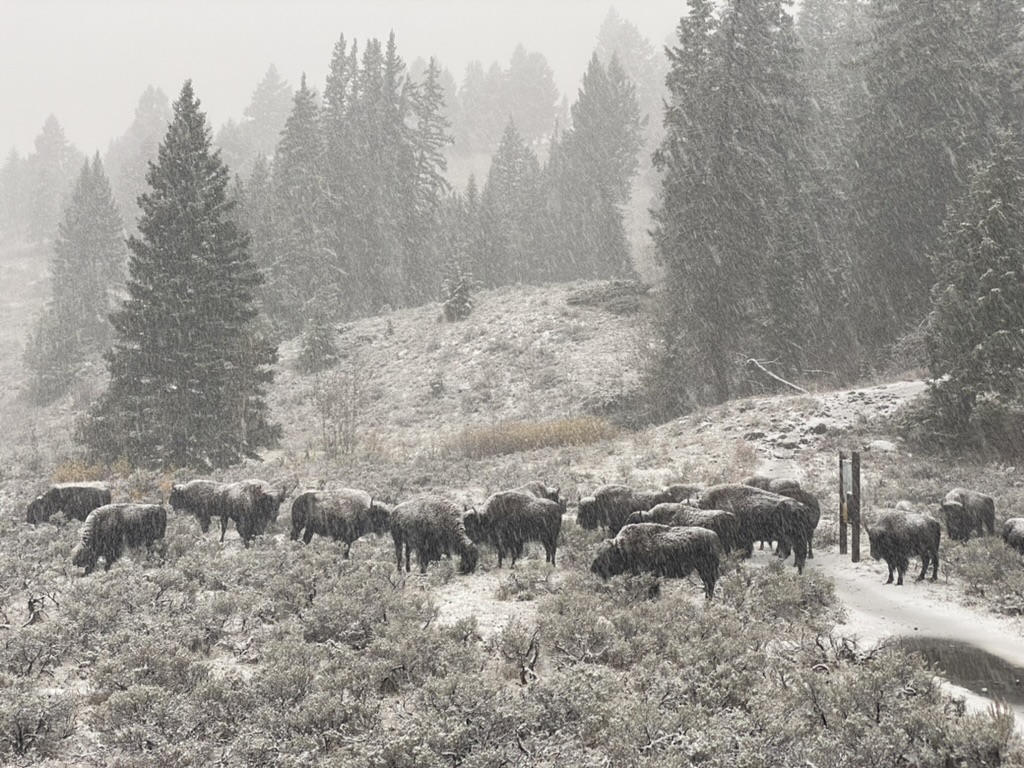Ken Burns’ new documentary The American Buffalo airs this week on PBS. Like everyone I’m eager to see how he explores the history surrounding this iconic creature.

Like everyone else, I will be eager to see how Ken Burns’ new documentary on the buffalo will explore the issue. I’m in the film. How much, I do not know. I’m told modestly in the first episode and then quite a bit in the second. We’ll see. By the time you read this, I will have seen the first episode (2 hours) and have a better sense of his purposes and priorities. I’m not even sure what I talked about in my interview for the film. It was several years ago.
I’m planning a drinking game. I hope to get blotto. More likely, a slight buzz of joy and pride and longing.
Yesterday, Sunday, October 15, I helped lead a group of well-wishers to Theodore Roosevelt’s Elkhorn Ranch, approximately 35 miles north of Medora, North Dakota. This was one of two ranches Roosevelt developed in the Little Missouri River Valley. He built a 30×60’ cottonwood ranch headquarters there. It’s gone, except for the foundation stones that mark its perimeter. And thank goodness, there is no proposal to rebuild the house on the site. It is one of America’s greatest shrines to conservation. A few cottonwood trees surrounding the house footprint might have been there when TR ranched and played cowboy in Dakota Territory (1883-1890).
Someone asked me how well buffalo do during the harsh Dakota winters. I answered that they have evolved over many millennia to be hearty enough to endure the long, windy, raw winters and thrive in them. They don’t move any more than they have to during the winter. This saves critically essential energy. They paw the snow away to get to what grass there is. They have thick protective skulls and grow long, dense hair (fur) to protect their vital body heat. Instead of turning away from the Arctic blasts of intense cold or the snow pressing in from the west, they turn into the storm and stand as still as possible for as long as it rages. Domestic cattle are wimps by comparison.
No wonder the Lakota and other Native Nations regarded the buffalo as sacred. It was not a quick-thinking and witty creature but had a profound baseline wisdom. It was the central species of Great Plains life for Native Americans. It supplied food, shelter, clothing, tools, agricultural implements, cooking pots, suitcases, fly swatters, glue, and more. And it was the center of Native American religious life. The Lakota myth of the White Buffalo Calf Woman is its central origin story. When the settler colonialists (American frontiersmen and their allies) extirpated nearly the entire buffalo population (once 35 or more million, eventually fewer than 500 critters), they destroyed the Native equivalent of the construction industry, the hardware store, the grocery store, the clothing industry, and the church or temple. They knew what they were doing. They were knocking out the structural pillars of the Native American world.
Fortunately, a few far-seeing individuals, including Theodore Roosevelt and William Hornaday, stepped in to save the buffalo from extinction. Native Americans played an important role, but most tribes were trying to survive during this period (1886-1930), and they were largely helpless to engage in rescue conservation initiatives. (It will be interesting to see how Ken Burns and his partner Dayton Duncan handle this). Today, there are more than half a million buffalo in North America. And the numbers are growing. Most western Native Nations now have buffalo herds.
I’m fortunate to live in the state of North Dakota. Any North Dakotan can see a free-ranging buffalo on any given day. You need to get yourself either to Theodore Roosevelt National Park, north or south unit (but not the Elkhorn unit), or to the MHA Indian Reservation in west central N.D. or the Standing Rock Lakota Reservation south of Bismarck on the Missouri spanning the N.D./S.D. border. And a few other places.
As I drove home yesterday in a strange and mysterious fog, I saw three buffalo standing amid a prairie-dog town looking as still as monuments. In a sense, they are. It would have been an ideal time to photograph them in that glorious state, but I had miles to go before I slept and promises to keep. I’m providing here a similar photograph of buffalo in “winter” (this was October) in Yellowstone National Park. Again, I am struck by their massive size, majesty, and placidity.

Three Observations on the Near-Extinction of the Buffalo
As I wait to see what Ken Burns has created, I want to stress three thoughts about the near-extinction of the buffalo.
First, it may have been the de facto policy of the U.S. government to exterminate the buffalo as a way of ending Native resistance to frontier intrusion, but it was never the overt policy of the government. Everyone understood that the best way to “pacify” plains tribes was to undercut their entire economy — their entire lifeway — by killing off at least the great majority of buffalo. U.S. Army officers spoke openly about the benefits the disappearance of the buffalo would bring. They encouraged the slaughter, but it is important to remember that the extermination of the buffalo was never formally adopted as U.S. Indian Policy.
Second, it is easy enough to condemn the wanton killing of buffalo by men (and some women) traveling over the western railroads. To our mind, it seems unconscionable. Individuals who committed this crime against Nature were encouraged to shoot at buffalo out of Pullman windows with rifles often provided by the railroads. They were told that it was perfectly acceptable to do so. They were told that the numbers of buffalo were so large as to be practically infinite and that killing a few dozen here and there would not make any material difference and that every dead buffalo hastened the time when “peace would come to the plains.” One of the severest problems in the history of America is the Myth of Endless Abundance. If there is an infinity of trees, why restrict the timber corporations? If there is an infinity of salmon, let the market decide how many to harvest each year. If there is an infinity of passenger pigeons, take your shot. If there is an infinity of fertile land to the west, why practice genuine stewardship in Virginia or Pennsylvania? There will always be new land in the West, and the nation’s government will help extinguish Native title to the lands in question. Little boys even now routinely kill pocket gophers or shoot dozens of prairie dogs in a single day with .22 caliber rifles. It is a relatively easy leap to the most majestic quadruped of North America.
The sad and banal fact is that the buffalo’s disappearance had more to do with opportunistic capitalism than any philosophy of western expansion. As historian Sara Dant puts it in Losing Eden, “Industrial America prized bison leather for making machine belts to power steam engines, as well as for furniture upholstery, lap robes for carriages, flannel-lined coats, shoes, and so on, and aggressive hide hunters and increasingly market-oriented Indians fanned out across the plains in pursuit of these lucrative animals.” At first, the buffalo were prized by frontiersmen for their meat. Then, their robes. Then, in the 1870s, new industrial techniques were developed (first in England) to fashion leather machine belts out of buffalo hides. This was the great industrial leap forward in buffalo extraction. Now, without government intervention, it was only a matter of time. Legislative attempts to restrain the slaughter, including those requiring the buffalo killer to harvest the meat from the carcass, were defeated, tabled, or vetoed throughout the western states and in Congress. Such tepid laws as were enacted were seldom enforced.
America has always been about the extraction of wealth from the natural resources of the West — those below the surface, those on the surface, and those above the surface. In America, virtually everything is fungible. From the dis-enchantment of the world that came with the Scientific Revolution, Anglo-Europeans looked at everything in Nature as potentially an object of wealth-creation, irrespective of its beauty, ecological importance, or right to exist.
The buffalo was a nuisance to American-style civilization. It was a lifeline for Native America. But the incentive to kill them all was pure plain profit-seeking.
Combine human acquisitiveness with American zeal for extraction with the law vacuum of the frontier with an acquiescent national government with the juggernaut of industrial extraction tools (the tractor, bulldozer, chain saw, 18-wheel truck, the railroad, and the Sharps rifle), and you are going to butt up against extinction. How many redwood trees would exist in America if local, state, and national conservation measures did not protect them?
You could probably cut down as many trees as you wished forever if your only tool was an axe, but once steam and diesel power came to the forest, the “skinning of the earth,” as Theodore Roosevelt called it, was entirely possible. Roosevelt rightly realized that only government supervision of the public forests could bring something like a sustained yield to the American timber industry. There were once so many salmon in the Columbia River basin that nobody thought they could ever be endangered.
I hope Theodore Roosevelt gets the praise he deserves in Ken Burns’ documentary. I know I emphasized his outlook, his role, and his greatness in the saving of the buffalo, which was only one element of the vast conservation agenda he brought to his time in power: 230 million acres of National Forest, National Monument, National Game Preserve, National Bird Sanctuary (National Wildlife Refuge), and National Park, the most significant conservation achievement of any president. Would the buffalo have been saved without Theodore Roosevelt? Probably, but not certainly.
The largest herd of buffalo in America now is at Yellowstone National Park, approximately 6,000. But the great achievement of the 21st century will be the American Prairie Reserve in east-central Montana. The APR already has ca. 3,500 buffalo, with a goal of 10 or more times that number. It’s a marvelous public-private partnership that may give the world a 3.5 million-acre buffalo commons on the Upper Missouri. If they succeed — and they almost certainly will — it will be one of the most enlightened achievements in American history.
Thank goodness for Theodore Roosevelt — William Hornaday, Scotty Philip, Charles Goodnight, Samuel Walking Coyote, and even William F. Cody. And thank goodness for Ken Burns and Dayton Duncan of Florentine Films.
